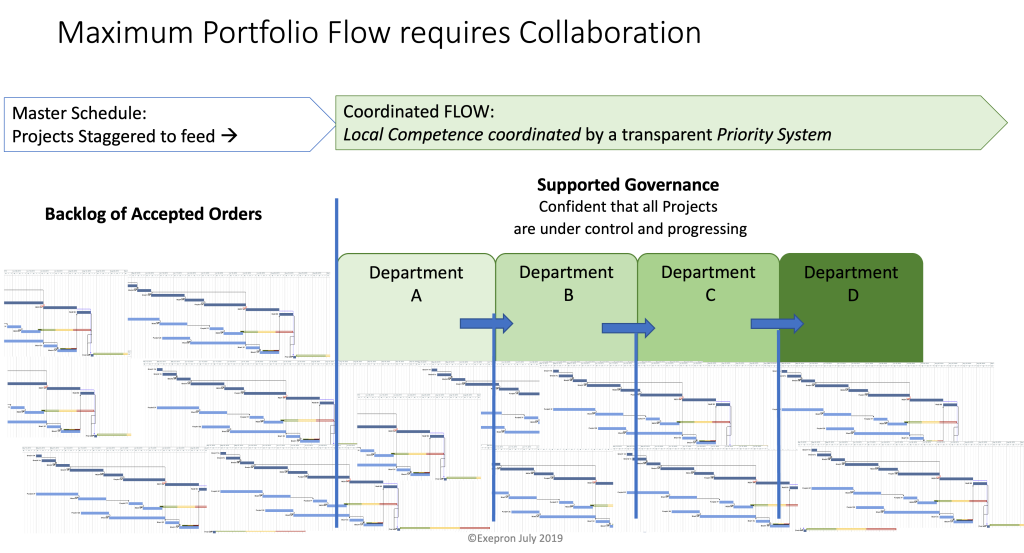Although technology and digitization have massively increased the topography of what can be measured in business, this does not mean we should.
Chapter 1: Conflicting Metrics: How Metrics Can Derail Delivery
If any metric conflicts with another metric, particularly if it contradicts the Global Metric of generating cash flow, it should be viewed with significant suspicion. This resembles playing “whack-a-mole, ” where one measure increases and causes another to decrease. An extreme case will be explored here.
Consider the real-world scenario of a large forestry company that sought greater efficiency through digitization and detailed measurement. To achieve optimal performance, the company enlisted a renowned consulting firm that recommended converting each department—from growing, felling, milling, processing, transporting, and distribution—into independent profit centers, each accountable for its profit and loss (P&L). PS. This included incentives for profitable Departments.
At first glance, the logic seemed flawless: if every department operates efficiently and profitably, the entire company will thrive and be profitable.
Unfortunately, reality revealed a different story. Deparmental silos of self-interest don’t work to synchronize operational FLOW.
As a result, only the transportation department profited from exploiting misalignment, overcharging transfer rates on the unplanned expedited timber movement.
Instead of encouraging interdepartmental collaboration, the newly established departmental profit metrics fostered self-interest. Each department pursued its profitability metrics, optimizing locally without considering the broader system.
Communication deteriorated rapidly as departmental performance metrics discouraged cooperation and synchronization. Once seamlessly handled at the operational level by supervisors, minor operational issues escalated to higher management and required executive intervention. Executives became overwhelmed and drawn into trivial departmental disputes rather than focusing on strategic initiatives to enhance overall cash flow and growth.
As departmental silos strengthened, customer service—a fundamental driver of cash flow—suffered greatly. Customers faced delays and quality issues directly from internal friction and lack of synchronization, damaging trust and revenue.
Deparmental Silo’s of Self Interest with Seniour Management coordinating even trivial disputes.

The critical mistake was apparent:
The metrics chosen, while technologically easy to measure, conflicted directly with the global objective of sustainable, synchronized cash flow generation.
The forestry company learned a harsh but valuable lesson: Metrics must never encourage local optimization at the expense of global business health. Technology and digitization provide unprecedented opportunities to measure and manage performance, but these opportunities must always serve the primary goal of generating sustainable cash flow.
The solution? Refocusing metrics on system-wide cooperation and profitability, the ultimate metric. When metrics align with the global objective, departments naturally collaborate, executives remain strategic, and the entire system thrives.
Remember, just because technology enables measurement doesn’t mean every measure matters. Your company’s future depends on it.
Chapter 2: Synchronization by Design — How Exepron Enables Flow
Where siloed metrics fail, system-level synchronization succeeds. That’s where Exepron comes in.
Exepron automatically synchronizes all operational flows and handoffs between departments and functions. It’s not just about tracking tasks; it’s about coordinating every task, resource, and dependency in real time to ensure flow across the entire operation.
From sales collecting initial customer requirements to engineering designing the product through manufacturing, fabrication, assembly, and final shipping and installation, every stage is connected through Exepron’s intelligent automation.
This transforms independent actions and silos into a super pipeline of synchronized orders that meet global metrics for timely and complete delivery of goods, projects, and services.

The Master Scheduler Staggers Project Release synchronized to Resource Availability.
Tasks are prioritized dynamically, resource conflicts are resolved at the operational level based on automated alerts, and dependencies are continuously managed.
Silos are broken down, and departments are synchronized. Exepron ensures that no department acts in isolation and that local priorities never override the system’s need for synchronized execution.
 What once required constant manual coordination and executive intervention now flows autonomously.
What once required constant manual coordination and executive intervention now flows autonomously.
A transparent priority system ensures operational issues previously escalated to leadership are resolved at the source because the system surfaces only the meaningful exceptions—those threatening on-time delivery or cash flow.
With Exepron, cross-functional synchronization is no longer a managerial burden. It’s a built-in feature.
Instead of departments optimizing in isolation, the entire organization operates as one synchronized system focused on the real goal: accelerating throughput and generating consistent cash flow.
This is how technology should be used—to reduce complexity, not create more of it.



